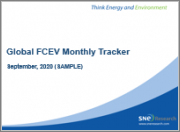
|
연간정보 서비스
상품코드
1004700
Global FCEV Monthly TrackerGlobal FCEV Monthly Tracker |
||||||
세계 주요 국가들이 기후 변화로 이산화탄소 감축을 위한 주요 정책을 발표했습니다. 정책의 핵심 중 하나는 친환경 자동차 도입을 통한 내연기관 자동차의 감소였습니다. 전세계적인 정책 흐름과 이를 맞추기 위한 완성차 업체들의 노력으로 전기자동차의 본격적인 전기차 시장이 열리기 시작했습니다.
하지만 활발한 인기를 얻고 있는 하이브리드 전기자동차(HEV), 플러그인 하이브리드 전기자동차(PHEV), 순수전기자동차(BEV) 외에 이제 막 시장이 열리기 시작한 전기차가 있습니다. 수소연료전지를 통한 에너지저장을 핵심으로 하는 수소연료전지 자동차(FCEV)가 그것입니다.
FCEV는 수소를 안전하게 보호해야 한다는 안전의 측면과 스택의 기술적 난이도 및 인프라 문제로 인해 초기 시장 성장이 비교적 더딘 모습을 보이고 있습니다.
그러나 FCEV는 여러가지 면에서 완성차 업체들이 관심을 가지고 개발할 장점을 가지고 있습니다. 첫째로 기존 BEV보다 더 긴 주행거리를 확보할 수 있습니다. 두번째는 BEV보다 빠른 충전 속도입니다. 현재 상용화된 양산 FCEV인 현대의 넥쏘는 5분만에 충전을 완료합니다. 시장 성장은 기존 전기차 대비 느릴지 모르나 향후 장거리 운송을 목적으로 하는 상용차 시장을 중심으로 빠른 성장이 전망됩니다.
본 리포트에서는 전세계에서 판매되는 FCEV의 판매량과 내부 핵심 부품인 스택 시스템, 그리고 배터리의 판매 규모 동향을 월별로 분석하였습니다. FCEV 판매대수를 지역별, FCEV 제조사별, 모델별은 물론 FCEV용 스택 시스템 제조업체별로도 집계함으로써 이들 스택 시스템 업체들의 글로벌 FCEV 시장점유율 현황도 명확히 확인할 수 있게 하였습니다. 아울러, FCEV 탑재 배터지 제조사의 사용량도 월별로 한눈에 파악할 수 있습니다.
- 전세계 유일의 글로벌 월별 수소연료전지 자동차 판매대수 및 배터리 탑재 실적 집계 DB
- 전세계 27개국의 총 230여 개 수소연료전지 자동차 모델 및 배터리 판매 DB를 기반으로 한 시장 분석 보고서 및 분석 툴 제공
- 조사 범위
-
-글로벌 수소연료전지차 판매 대상 대륙 및 국가 : 전세계 7개 대륙, 총 27개국
-글로벌 수소연료전지차 제조업체 : 총 37개 수소연료전지 자동차 제조사
-글로벌 수소연료전지스택 시스템 공급업체 : 총 12개 시스템 제조업체
-글로벌 수소연료전지차 배터리 공급업체 : 총 25개 배터리업체
-글로벌 수소연료전지차 판매대수 : 자동차 유형별, 국가별, 대륙별, 자동차 제조업체별, 모델별, 수소연료전지스택 시스템 공급업체별
-글로벌 수소연료전지스택 단위 용량(kw) : 모델별
-글로벌 수소연료전지차용 배터리 사용량 : 배터리 업체별, 배터리 타입별, 배터리 종류별
-차량 유형 : PV (Passenger Vehicle), CV (Commercial Vehicle => Bus, Truck)
- The world's unique DB computed on the sales performance of monthly global hydrogen fuel cell vehicle batteries and stacks
- Provides market analysis reports and analysis tools based on the sales DB of a total of more than 130 hydrogen fuel cell vehicle models and batteries in 23 countries around the world
Major countries around the world have announced major policies to reduce carbon dioxide according to climate changes. One of the key points of the policies was reducing internal combustion engine vehicles through the introduction of eco-friendly vehicles. With the global policy trend and the efforts of automakers to meet this trend, the full-scale electric vehicle (EV) market has begun to open up.
However, in addition to the hybrid electric vehicle (HEV), plug-in hybrid electric vehicle (PHEV), and pure battery electric vehicle (BEV), which are actively becoming popular, there is another electric vehicle whose market has just started to open. It is the hydrogen fuel cell electric vehicle (FCEV) that focuses on energy storage through hydrogen fuel cells.
In the FCEV, the initial market growth relatively appears slow due to the safety aspect that hydrogen must be safely protected, the technical difficulty of the stack, and the infrastructure issues.
However, FCEV has advantages for which automakers will become interested in developing in many ways. First, it can secure longer mileage than the existing BEV. Second, its charging speed is faster than BEVs. Hyundai's Nexo, which is commercialized at present and is a mass-produced FCEV, can be charged just in 5 minutes. Although the market growth may be slower than that of existing EVs, it is expected to grow rapidly in the future, centered on the commercial vehicle (CV) market intended for long-distance transportation.
In this report, we analyzed by month the sales volume of FCEVs sold worldwide, stacks which are internal core parts, and battery sales volume trends. By analyzing FCEV sales by Fuel Cell Stack system suppliers as well as by region, by FCEV manufacturer, by model, it is possible to see market share of Stack system suppliers. It is also possible to understand at a glance by month battery suppliers' battery installation equipped to FCEV.
Research Scope
- Targeted continents and countries for global FCEV sales: a total of 23 countries in 7 continents around the world,
- Global FCEV manufacturer: A total of 35 FCEV manufacturers
- Global Fuel Cell Stack system supplier : A total 11 system suppliers
- Global FCEV battery suppliers: A total of 24 battery companies
Contents
- Global FCEV Sales : by vehicle type, by country, by continent, by OEM, by model, by Fuel Cell Stack system supplier
- Global Fuel Cell Stack unit (kw) : by model
- Global Battery Installation for FCEV : by battery supplier, by battery type, by battery chemical
Provision Method
- Excel pivot table report: Available for various database analyses
- Provides the previous month(n) results on last working day of following month or beginning of the month(n+2)
Substance
1. Monthly Sales Trend of FCEV - Type, Country, Continents, Group, Maker(OEM), Model, Fuel Cell Stack supplier
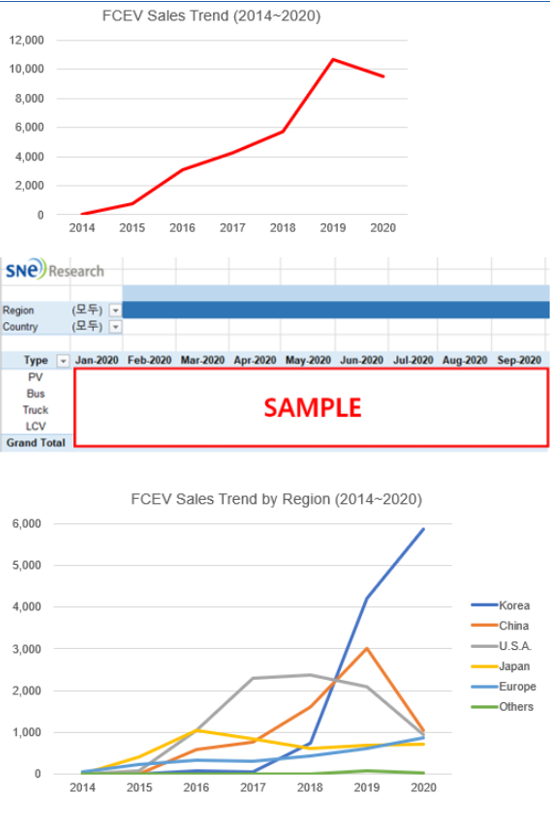
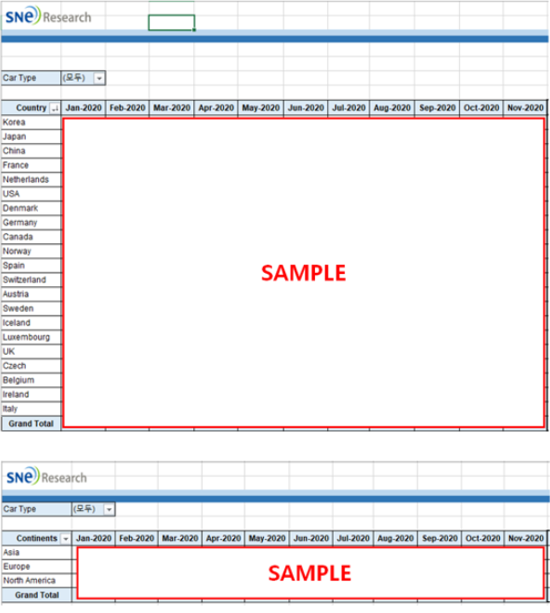
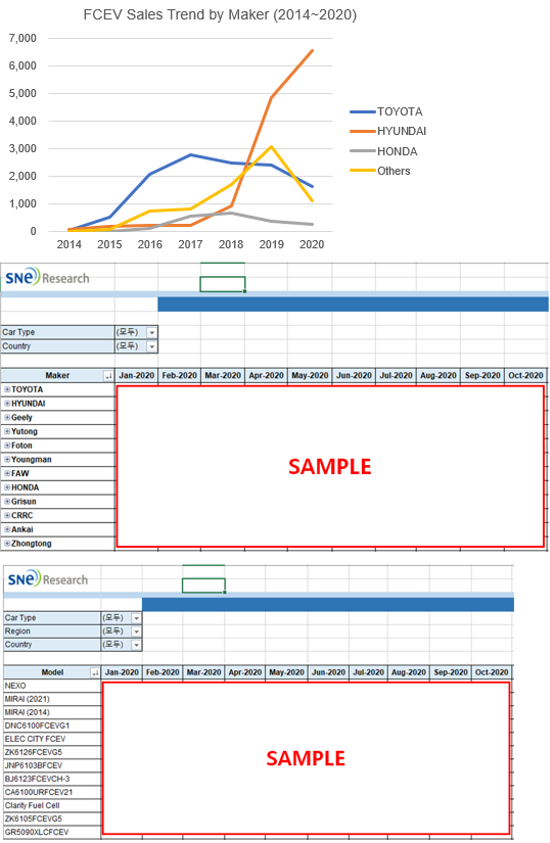
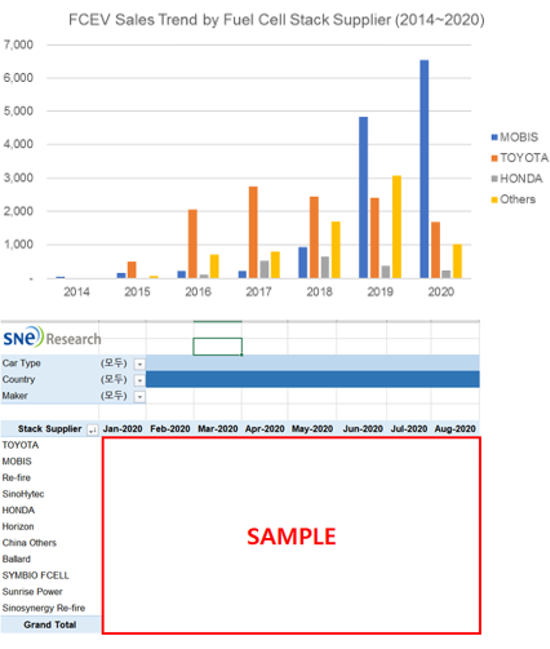
2. Fuel Cell Stack Capacity (kw) by FCEV models
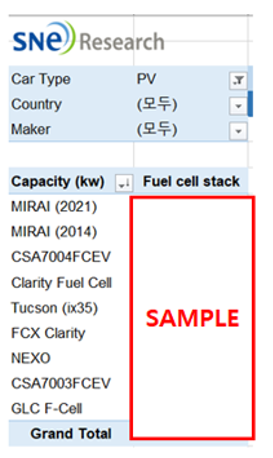
3. Monthly Battery Installation Trend of FCEV - Battery Supplier, Battery Type, Battery Chemical
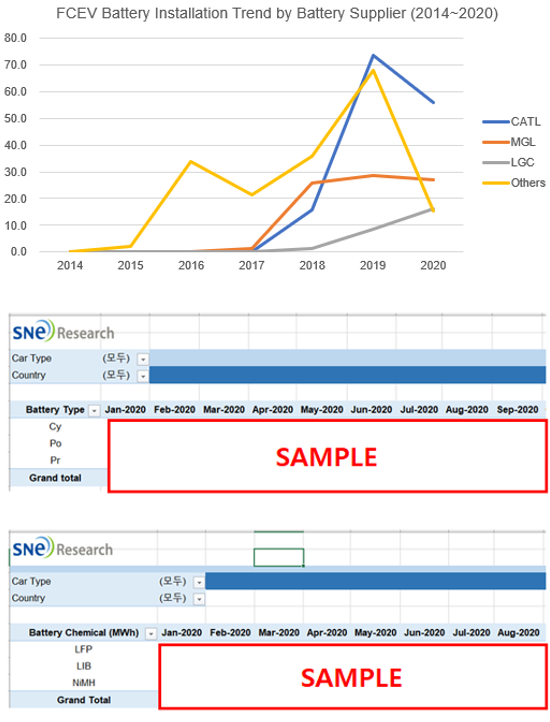
(주말 및 공휴일 제외)


















